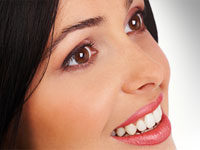Dental Veneers - The Ultra-Thin Solution to Damaged Teeth

Do you have a weakened, discolored or broken tooth, or teeth, you wish could be improved without having them reduced in size and replaced with dental crowns? Until quite recently, a crown was your only alternative. But not any more. Now that tooth or teeth can be saved and looking fabulous with elegant, life-like porcelain veneers.
Dental veneers are less expensive than crowns, easier on the patient, and relatively quick to place. You could call them "instant orthodontics."
And forget about those thick, heavy, "clunky" tooth veneers of five to ten years ago. Today's dental veneers are ultra-thin and very light, bonded to just the front of the tooth. Cosmetically and technologically speaking, there's no comparison. You have to see them to believe them.
This type of cosmetic dentistry is an inexpensive, simple way to hide a multitude of "Smile Sins." It is easy to improve the look and translucence of teeth stained by early tetracycline use, or years of coffee and tea stains. A minor chip or irregularity can be corrected in a flash with a veneer. No pain, no strain, nothing but the perfect tooth restoration you've always wanted.
Misshapen or overlapping front teeth? By removing just a tiny fraction of enamel and placing tooth veneers, your front teeth can be contoured or straightened. Best of all, a single office visit to a cosmetic dental professional usually does the trick.
The prosthodontics procedures available today are high-tech and versatile. Call your cosmetic dentist for a consultation, and see if a dental makeover can give you a whole new smile!

+Jim Du Molin is a leading Internet search expert helping individuals and families connect with the right dentist in their area. Visit his author page.
Your Dental Makeover: Discover How Plastic Surgery Relates To Cosmetic Dentistry

Cosmetic dentistry and plastic surgery both blend health care with artistry and beautification. However, before we can beautify a person's smile, we must have a complete understanding of your dental makeover, not just an appreciation of, beauty.
Some of the first people to understand beauty were not health care specialists, but rather, artists. Great painters and sculptors studied anatomy, perspective, illusion, proportion, idealism and symmetry in order to recreate the beauty they saw.
Esthetic surgeons and cosmetic dentists create better-looking smiles. A cosmetic dentist creates pleasing-looking teeth, while the surgeon helps you feel more like smiling.
If cosmetic dentists and esthetic surgeons want to create beautiful smiles, they must begin to think like the great dental makeover artists. Michelangelo would never have considered one of his masterpieces complete until it was framed properly. The same goes for cosmetic dentistry. If we think of the teeth as the masterpiece, the frame is the surrounding soft tissue (such as the gums, jawbones, facial muscles, lips, and skin). We cannot consider one without the other.
Let's look at the areas of the face that contribute to the smile.
The Lips Form the Smile
The support of the lips is very important. If the teeth are properly contoured and there is a normal bite, the lip support is nearly always adequate. When it is inadequate, it is correctable.
Aside from the teeth, the chin also plays a role in the shape of the lips. A weak chin can give lips a protruded appearance. The solution is to increase the fullness of the chin through cosmetic plastic surgery.
The Mouth Is the Center of the Smile
The next area of cosmetic dentistry focus in your dental makeover is the shape of the mouth. The lips and the teeth are of primary importance to the support of the lips; however, the facial muscles of expression are what control the smile.
When the corners of the mouth are either turned up or down, they convey the feeling of happiness or sadness. Soft tissue corrections around the mouth should be corrected after the teeth and jawbones are corrected.
Other facial features that can be surgically altered to contribute to a terrific smile are:
- The nose may shadow the smile; The nose helps to proportion the smile in how it relates to the mouth and cheeks.
- The chin aids in determining facial balance; A prominent or deficient chin can affect facial symmetry.
- The jaws help shape the face and smile; A deficient upper or lower jaw can divert attention away from the smile and lay focus on the deficiency.
- The cheeks lift the corner of the smile; Sagging facial tissue that hides nicely-shaped lips, cheeks, and jawbones can be "lifted" to once again feature a pleasing smile.
- The brows and lids usually contribute greatly to the smile; thick upper eyelids that make people look tired or sad can be thinned.
- The skin may be wrinkled by smiling or frowning; Small facial muscles placing tension on the skin sometimes cause fine aging lines. They can be corrected through chemical peels, Botox injections, dermabrasion or a combination of these along with a facelift.
For further information on your dental makeover, consult with a cosmetic dentist, dermatologist or plastic surgeon. Each of these specialists works in close relationship with each other and can further counsel you on the best cosmetic dentistry treatment to improve your smile.
By Benjamin O. Watkins, III, DDS

+Jim Du Molin is a leading Internet search expert helping individuals and families connect with the right dentist in their area. Visit his author page.




